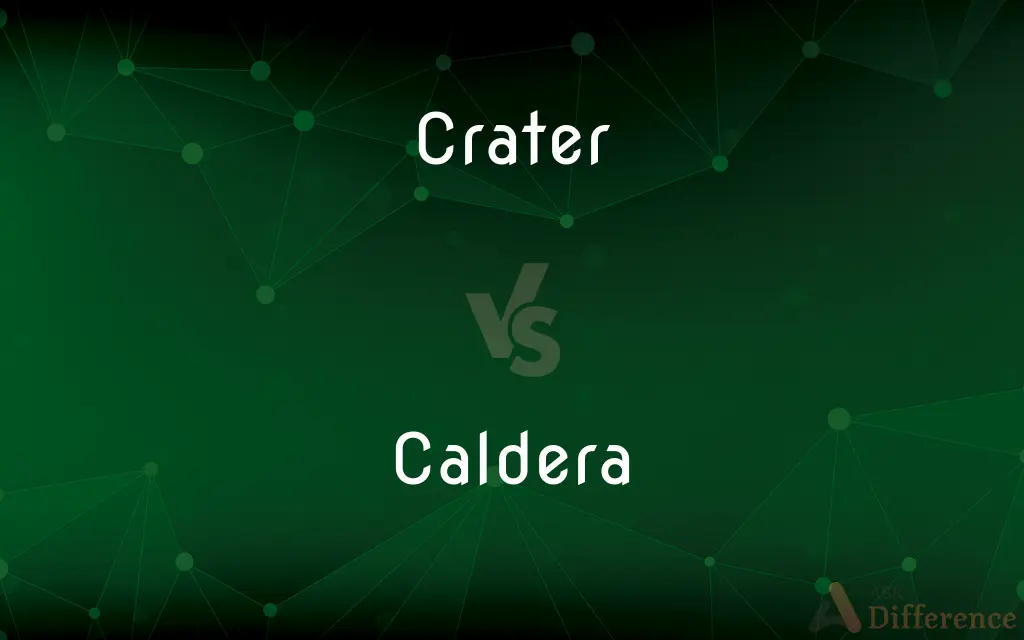Crater vs. Caldera — What's the Difference?
By Tayyaba Rehman — Updated on November 5, 2023
A crater is a bowl-shaped depression typically caused by volcanic activity or meteorite impact, while a caldera is a large volcanic crater, usually formed by a major eruption leading to the collapse of the mouth of the volcano.

Difference Between Crater and Caldera
Table of Contents
ADVERTISEMENT
Key Differences
A crater is a general term for a circular depression in the ground caused by an energetic event like a volcanic eruption, impact event, or explosion. Craters can be found on planets and moons, showing evidence of past collisions or volcanic activity. Their size can vary from small, simple, bowl-shaped depressions to large, complex structures.
Calderas, on the other hand, are a specific type of large crater that forms through the collapse of land following a volcanic eruption. They are distinguished by their size, often exceeding one kilometer in diameter, and are sometimes so large that they can be mistaken for valleys or basins. Calderas are almost exclusively the result of volcanic processes.
When a volcano erupts, it can empty its magma chamber so rapidly that the ground above it collapses, forming a caldera. This process can happen over hours or days during explosive eruptions, or the caldera can form through the gradual subsidence of the ground due to long-term volcanic activity.
Craters can be simple structures with a raised rim, caused by an explosion that throws out material from the impact. However, a caldera's formation is more complex and involves not just ejection but also the sinking of the volcano's mouth. This leads to a large depression that is often misshapen and larger than the original volcanic vent.
In summary, while all calderas are technically craters, not all craters are calderas. The term "crater" can be applied broadly to any similar depression, while "caldera" is used for a specific geological structure formed by certain volcanic events.
ADVERTISEMENT
Comparison Chart
Formation
Impact, explosion, or volcanic activity
Collapse of land after a major volcanic eruption
Size
Generally smaller than calderas
Usually larger, often over a kilometer in diameter
Shape
Typically circular with a raised rim
Large, often irregularly shaped due to collapse
Occurrence
Can occur on planets, moons, and Earth
Primarily on Earth associated with volcanoes
Associated Activity
Can be inactive or result from a one-time event
Often a sign of significant past volcanic activity
Compare with Definitions
Crater
A depression formed by a volcanic eruption
Smoke rose from the crater of the active volcano.
Caldera
A massive depression that can host lakes due to its size
The caldera was so large it contained an entire ecosystem within it.
Crater
The space surrounded by the opening of a volcano
They hiked to the edge of the volcano's crater.
Caldera
An extensive volcanic feature that indicates a catastrophic eruption in the past
Geologists studied the caldera to understand the volcano's history.
Crater
A hollow or pit in a surface
The explosion created a crater in the middle of the street.
Caldera
A large volcanic crater formed by a major eruption and subsequent collapse of the mouth of the volcano
Yellowstone is a famous caldera.
Crater
A small and faint southern constellation (the Cup), between Hydra and Leo, said to represent the goblet of Apollo.
Caldera
A term specifically referring to the large scale and complex formation process of a volcanic crater
The caldera's formation was studied over decades by scientists.
Crater
Form a crater in (the ground or a planet)
Pilots returned to the airfields to crater the runways
Caldera
A basin-like feature formed by the collapse of land after volcanic activity
The lake is actually a water-filled caldera.
Crater
A constellation in the Southern Hemisphere near Hydra and Corvus.
Caldera
A caldera is a large cauldron-like hollow that forms shortly after the emptying of a magma chamber in a volcanic eruption. When large volumes of magma are erupted over a short time, structural support for the rock above the magma chamber is lost.
Crater
A bowl-shaped depression created by the activity of a volcano or geyser.
Caldera
A large volcanic crater, especially one formed by a major eruption leading to the collapse of the mouth of the volcano.
Crater
A bowl-shaped depression in a surface made by an explosion or the impact of a body, such as a meteoroid.
Caldera
A large crater formed by volcanic explosion or by collapse of a volcanic cone.
Crater
A pit; a hollow.
Caldera
(vulcanology) A large crater formed by collapse of the cone or edifice of a volcano.
Crater
Variant ofkrater.
Caldera
A large crater caused by the violent explosion of a volcano that collapses into a depression
Crater
To make craters in:"The missiles did not ... crater the airfield"(Tom Clancy).
Crater
To form a crater or craters.
Crater
To fall and crash violently from a great height.
Crater
To fail utterly:"talked about how tough times were in Texas since the oil business cratered"(Stephen Coonts).
Crater
(astronomy) A hemispherical pit created by the impact of a meteorite or other object.
Crater
(geology) The basin-like opening or mouth of a volcano, through which the chief eruption comes; similarly, the mouth of a geyser, about which a cone of silica is often built up.
Crater
The pit left by the explosion of a mine or bomb.
Crater
Any large, roughly circular depression or hole.
Crater
(historical) krater
Crater
To form craters in a surface.
Crater
(figurative) To collapse catastrophically; to become devastated or completely destroyed.
Crater
(snowboarding) To crash or fall.
He cratered into that snow bank about five seconds after his first lesson.
Crater
The basinlike opening or mouth of a volcano, through which the chief eruption comes; similarly, the mouth of a geyser, about which a cone of silica is often built up.
Crater
The pit left by the explosion of a bomb, shell, or mine.
Crater
A constellation of the southen hemisphere; - called also the Cup.
Crater
A bowl-shaped opening at the top of a volcano
Crater
A faint constellation in the southern hemisphere near Hydra and Corvus
Crater
A bowl-shaped depression formed by the impact of a meteorite or bomb
Crater
A bowl-shaped geological formation at the site of a meteorite impact
The meteor left a large crater in the desert.
Crater
A marked indentation caused by an impact or explosion
Craters on the moon are visible through a telescope.
Common Curiosities
What is a crater?
A crater is a bowl-shaped depression caused by an impact, explosion, or volcanic eruption.
Are all volcanic depressions calderas?
No, only large ones formed by the collapse of a magma chamber are considered calderas.
Are calderas dangerous?
Calderas can be geologically active areas, posing various hazards such as eruptions or geothermal activity.
Is a caldera always larger than a crater?
Calderas are generally larger than most other types of craters due to the scale of volcanic activity required to form them.
Can craters have water in them?
Yes, some craters can hold water and become lakes.
Can a crater be found on other celestial bodies?
Yes, craters are common on planets and moons that have been struck by meteorites.
Can a crater be formed by something other than a meteorite impact?
Yes, craters can also form from volcanic activity or man-made explosions.
How can you tell a crater from a caldera?
Calderas are usually much larger and formed from volcanic collapse, whereas craters can be smaller and result from various events.
How is a caldera formed?
A caldera forms when a volcano's magma chamber empties and the land above collapses.
Do calderas only form on Earth?
While most known calderas are on Earth, similar structures might be found on other volcanic worlds.
Is there a size limit to what constitutes a crater versus a caldera?
Generally, calderas are larger than one kilometer in diameter, but there's no strict size limit distinguishing them from other craters.
Do calderas change over time?
Yes, they can be altered by ongoing volcanic activity, erosion, and sedimentation.
Can new craters form within calderas?
Yes, post-caldera eruptions can create new craters within a caldera.
Are all craters round?
Most are, but complex cratering events can create irregular shapes.
Can craters and calderas support life?
Yes, both can develop ecosystems, especially if they host water.
Share Your Discovery

Previous Comparison
Weird vs. Strange
Next Comparison
Kettle vs. TeapotAuthor Spotlight
Written by
Tayyaba RehmanTayyaba Rehman is a distinguished writer, currently serving as a primary contributor to askdifference.com. As a researcher in semantics and etymology, Tayyaba's passion for the complexity of languages and their distinctions has found a perfect home on the platform. Tayyaba delves into the intricacies of language, distinguishing between commonly confused words and phrases, thereby providing clarity for readers worldwide.















































